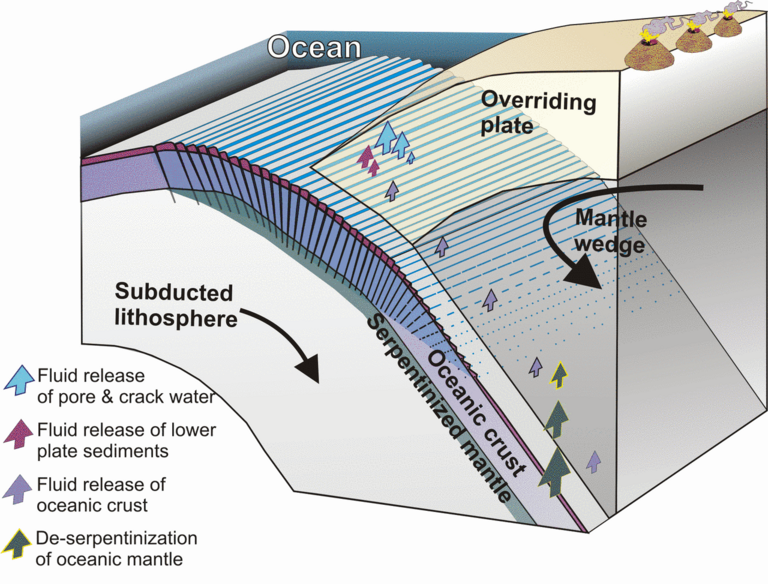Water pathways from the deep-sea to volcanoes
December 20, 2010/Kiel, Germany. Oceanic plates take up a lot of water when submerged into the Earths’ interior at continental margins. This water plays a central role in plate boundary volcanism. A team of the Collaborative Research Centre (SFB) 574 “Fluids and Volatiles in Subduction Zones” in Kiel (Germany) has for the first time tracked the pathway of the water up to 120 kilometre depth. This is an important piece in the puzzle to understand the highly active volcanoes in Pacific “ring of fire”. The study has recently been published in the international journal Nature Geoscience.
It is hard to imagine a greater difference than between fire and water. But there is a close connection. Scientists know: many volcanoes need water for their eruption. In the upper mantle, water lowers the melting temperature of the rocks. As a consequence, it melts faster and can ascend in form of magma to the Earth's surface.
In areas where an oceanic plate is pushed underneath a continent by plate tectonics processes, large quantities of water reach the interior of the Earth. Such a region, called subduction zone, can be found at the west coast of Latin and South America. Through large cracks formed during the subduction process of the oceanic plates water penetrates, is partly captured and transported in the mantle. There, high pressure and temperatures squeeze it out of the subducting plate and the water ascends back to the surface. On the way back it supports the formation of magma. Therefore all subduction zones are characterized by volcanoes at the continental margin. “So far we knew that the entrainment of water into the Earth's mantle in the area of subductions zones is substantial and that it is released again by volcanic process. Nevertheless, the exact path of the water down to the mantle and back to the surface had so far not been shown in one unifying context”, explains Tamara Worzewski, geophysicist in the Collaborative Research Centre (SFB) 574 “Fluids and Volatiles in Subduction Zones – Climate Feedback and Trigger Mechanisms for Natural Hazards” who has investigated these processes. Together with Dr. Marion Jegen and Prof. Dr. Heidrun Kopp from the Leibniz Institute of Marine Sciences at the Christian-Albrechts-Universität (IFM-GEOMAR) in Kiel and colleagues Dr. Heinrich Brasse from the Freie Universität Berlin and Dr. Waldo Taylor from Costa Rica, she was able to show for the first time the complete water path from the seafloor down to 120 kilometre depth and back to the surface using electromagnetic methods. The study, now published in Nature Geoscience, is also part of Worzewskis PhD Study.
For her investigations, the scientists used the magnetotelluric method. Here, special instruments measure changes in the Earths’ electromagnetic field from which the distribution of the conductivity of the ground can be derived. “Because of their higher conductivity aqueous rocks can be detected quite well”, explains Worzewski. On land, this method has already been successfully used for some time. But at the seafloor, its application is rather new. “Measurements at greater depths are simply much more difficult”, explains Dr. Marion Jegen, co-author of the study and supervisor of Worzewski's PhD study. Dr. Jegen is also heading a working group on magnetotelluric at SFB 574 and established the method for marine applications in Germany. In 2007 and 2008, a continuous chain of instruments was distributed across the subduction zone off the coast of Coast Rica. It extended from 200 kilometres off the coast to 160 kilometres on land beyond the volcanic chain in Costa Rica. “The instruments on land were supplied by the Freie Universität Berlin, while at the seafloor the new instruments developed in Kiel were used“, Dr. Jegen reports. With the new data Tamara Worzewski and her co-authors were able to visualize the water cycle in subduction zones for the first time. „We have indications that the water enrichment process of the crust that we detected locally can be found in subduction zones globally“, Worzewski says. Nevertheless more research is required to explain the process in more detail.
“The publication in a high-ranking journal like Nature Geoscience documents the importance of the results of this study”, states Prof Heidrun Kopp from IFM-GEOMAR who is also co-author of the study. “It is outstanding that a paper with first-authorship of a PhD student is accepted in such a journal. It documents the excellent quality of Tamara's evaluation of the data.”
Background information:
In the Collaborative Research Centre (SFB) 574 “Fluids and Volatiles in Subduction Zones – Climate Feedback and Trigger Mechanisms for Natural Hazards" geologists, volcanologists, geophysicists, geochemists but also meteorologists and biologists of Christian-Albrechts-Universität and the Leibniz Institute of Marine Sciences (IFM-GEOMAR) in Kiel are working on a better understanding of the processes during the subduction of oceanic plates under a continent. Main research areas are the Pacific coast in Latin America from Costa Rica to Guatemala and the subduction zone in southern Chile. The German Research Foundation (DFG) supports the SFB 574 with 6 million Euros until 2012.
Original Paper
Worzewski, T., M. Jegen, H. Kopp, H. Brasse and W.T. Castillo, 2010: Magnetotelluric image of the fluid cycle in the Costa Rican subduction zone. Nature Geocience, http://dx.doi.org/10.1038/NGEO1041.
Contact:
Jan Steffen (Communication & Media), Phone: +49-431 600-2811, presse(at)geomar.de jsteffen(at)ifm-geomar.de





